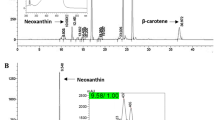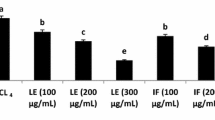Abstract
Carbon tetrachloride (CCl4) is widely used to induce liver toxicity in in vitro/in vivo models. Lipid peroxidation (LPO) begins with toxicity and affects cell viability. Recently, the beneficial effects of melatonin and Vitamin D on cell proliferation in human normal and cancer cells were found. This study was planned to evaluate antioxidant and cytoprotective activity of melatonin and Vitamin D in CCl4 induced cytotoxicity in HepG2 and Hep3B hepatoma cell lines. Based on the cytotoxicity assay, melatonin and Vitamin D were evaluated for cytotoprotective potential against CCl4 induced toxicity in HepG2 and Hep3B liver cell lines by monitoring cell viability, LPO and glutathione (GSH) level. Different dosages of CCl4 (0.1, 0.2, 0.3 and 0.4 % v/v) were applied to HepG2 and Hep3B cells in order to determine the most toxic dosage of it in a time dependent manner. The same experiments were repeated with exogenously applied melatonin (MEL) and Vitamin D to groups treated with/without CCL4. Cell viability was determined with MTT measurements at the 2nd, 24th and 48th h. GSH content and Malondialdehyde levels were measured from the cell lysates. As a result, both melatonin and Vitamin D administration during CCl4 exposure protected liver cells from CCl4 induced cell damage. Increase in LPO and decrease in GSH were found in the CCl4 groups of both cells. Contrary to these results administration of MEL and Vitamin D on cells exhibited results similar to the control groups. Therefore, melatonin and Vitamin D might be a promising therapeutic agent in several toxic hepatic diseases.




Similar content being viewed by others
References
Abramovitch S, Dahan-Bachar L, Sharvit E, Weisman Y, Ben Tov A, Brazowski E, Reif S (2011) Vitamin D inhibits proliferation and profibrotic marker expression in hepatic stellate cells and decreases thioacetamide-induced liver fibrosis in rats. Gut 60:1728–1737
Agency for Toxic Substances and Disease Registry (ATSDR) (2005) Toxicological profile for carbon tetrachloride. U.S. Department of Health and Human Services, Public Health Service, Atlanta, GA
Akhter J, Lu Y, Finlay I, Pourgholami MH, Morris DL (2001) 1α,25(OH)2D3 and its analogues, EB1089 and CB1093, profoundly inhibit the in vitro proliferation of the human hepatoblastoma cell line HepG2. ANZ J Surg 71:414–417
Binderup L, Bramm E (1988) Effects of a novel vitamin D analogue MC 903 on cell proliferation and differentiation in vitro and on calcium metabolism in vivo. Biochem Pharmacol 37:889–895
Bollag WB, Ducote J, Harmon CS (1995) Biphasic effect of 1,25-dihyroxyvitamin D3 on primary mouse epidermal keratinocyte proliferation. J Cell Physiol 163:248–256
Bonior J, Jaworek J, Konturek SJ, Pawlik WW (2005) Increase of heat shock protein gene expression by melatonin in AR42J cells. J Physiol Pharmacol 56:471–481
Buege J, Aust S (1978) Microsomal lipid peroxidation. Methods Enzymol 52:302–310
Cabrera J, Negrín G, Estévez F, Loro J, Reiter RJ, Quintana J (2010) Melatonin decreases cell proliferation and induces melanogenesis in human melanoma SK-MEL-1 cells. J Pineal Res 49:45–54
Carbajo-Pescador S, Martín-Renedo J, García-Palomo A, Tuñón MJ, Mauriz JL, González-Gallego J (2009) Changes in the expression of melatonin receptors induced by melatonin treatment in hepatocarcinoma HepG2 cells. J Pineal Res 47:330–338
Cid MA, Ubeda A, Hernández-Bule ML, Martínez MA, Trillo MÁ (2012) Antagonistic effects of a 50 Hz magnetic field and melatonin in the proliferation and differentiation of hepatocarcinoma cells. Cell Physiol Biochem 30:1502–1516
Cos S, Garcia-Bolado A, Sánchez-Barceló EJ (2001) Direct antiproliferative effects of melatonin on two metastatic cell sublines of mouse melanoma (B16BL6 and PG19). Melanoma Res 11:197–201
DeLuca HF (2008) Evolution of our understanding of vitamin D. Nutr Rev 66 :573e8
Ding J, Yu J, Wang C, Hu W, Li D, Luo Y, Luo H, Yu H (2005) Ginkgo biloba extract alleviates liver fibrosis induced by CCl4 in rats. Liver Int 25:1224–1232
Eisman JA, Koga M, Sutherland RL, Barkla DH, Tutton PJM (1989) 1,25-Dihydroxyvitamin D3 and the regulation of human cancer cell replication. Proc Soc Exp Biol Med 191:221–226
El-Missiry MA, Fayed TA, El-Sawy MR, El-Sayed AA (2007) Ameliorative effect of melatonin against gamma-irradiation-induced oxidative stress and tissue injury. Ecotoxicol Environ Saf 66:278–286
Fan LL, Sun GP, Wei W, Wang ZG, Ge L, Fu WZ, Wang H (2010) Melatonin and doxorubicin synergistically induce cell apoptosis in human hepatoma cell lines. World J Gastroenterol 16:1473–1481
Gulcin I, Buyukokuroglu ME, Oktay M, Kufrevioglu OI (2002) On the in vitro antioxidative properties of melatonin. J Pineal Res 33:167–171
Harries HM, Fletcher ST, Duggan CM, Baker VA (2001) The use of genomic technology to investigate gene expression changes in cultured human liver cells. Toxicol In Vitro 15:399–405
Hong RT, Xu JM, Mei Q (2009) Melatonin ameliorates experimental hepatic fibrosis induced by carbon tetrachloride in rats. World J Gastroenterol 15:1452–1458
Jain SK, Micinski D (2013) Vitamin D upregulates glutamate cysteine ligase and glutathione reductase, and GSH formation, and decreases ROS and MCP-1 and IL-8 secretion in high-glucose exposed U937 monocytes. Biochem Biophys Res Commun19:437:7-11
Kaya H, Oral B, Ozguner F, Tahan V, Babar Y, Delibas N (1999) The effect of melatonin application on lipid peroxidation during cyclophosphamide therapy in female rats. Zentralbl Gynakol 12:499–502
Kim SY, Kim RH, Huh TL, Park JW (2001) Alpha-phenyl-N-t-butylnitrone protects oxidative damage to HepG2 cells. J Biochem Mol Biol 34:43–46
Knowles BB, Howe CC, Aden DP (1980) Human hepatocellular carcinoma cell lines secrete the major plasma proteins and hepatitis B surface antigen. Science 209:497–499
Kragballe K (1992) Vitamin D analogues in the treatment of psoriasis. J Cell Biochem 49:46–52
Krithika R, Mohankumarb R, Vermaa RJ, Shrivastavc PS, Mohamadd IM, Gunasekarand S, Narasimhanb S (2009) Isolation, characterization and antioxidative effect of phyllanthin against CCl4-induced toxicity in HepG2 cell line. Chem-Biol Interact 181:351–358
Krithika R, Verma RJ, Shrivastav PS (2012) Antioxidative and cytoprotective effects of andrographolide against CCl4-induced hepatotoxicity in HepG2 cells. Hum Exp Toxicol 32:530–543
Liu JY, Chen CC, Wang WH, Hsu JD, Yang MY, Wang CJ (2006) The protective effects of Hibiscus sabdariffa extract on CCl4-induced liver fibrosis in rats. Food Chem Toxicol 44:336–343
Lutzow-Holm C, De Angelis P, Grosvik H, Clausen OP (1993) 1,25-Dihyroxyvitamin D3 and the vitamin D analogue KH1060 induce hyperproliferation in normal mouse epidermis. A BrdUrd/DNA flow cytometric study. Exp Dermatol 2:113–120
Maestroni GJ, Conti A (1996) Melatonin in human breast cancer tissue: association with nuclear grade and estrogen receptor status. Lab Invest 75:557–561
Marelli MM, Limonta P, Maggi R, Motta M, Marelli RM (2000) Growth-inhibitory activity of melatonin on human androgen-independent DU 145 prostate cancer cells. Prostate 45:238–244
Marques TG, Chaib E, da Fonseca JH, Lourenço AC, Silva FD, Ribeiro MA Jr, Galvão FH, D'Albuquerque LA (2012) Review of experimental models for inducing hepatic cirrhosis by bile duct ligation and carbon tetrachloride injection. Acta Cir Bras 27:589–594
Martín V, Herrera F, García-Santos G, Antolín I, Rodriguez-Blanco J, Medina M, Rodriguez C (2007) Involvement of protein kinase C in melatonin’s oncostatic effect in C6 glioma cells. J Pineal Res 43:239–244
Martín-Renedo J, Mauriz JL, Jorquera F, Ruiz-Andrés O, González P, González-Gallego J (2008) Melatonin induces cell cycle arrest and apoptosis in hepatocarcinoma HepG2 cell line. J Pineal Res 45:532–540
Masuda S, Byford V, Kremer R (1996) In vitro metabolism of the vitamin D analog, 22-oxacalcitriol, using culture osteosarcoma, hepatoma and keratinocyte cell lines. J Biol Chem 271:8700–8718
Moriya T, Horie N, Mitome M, Shinohara K (2007) Melatonin influences the proliferative and differentiative activity of neural stem cells. J Pineal Res 42:411–418
Martin MA, Ramos S, Mateos R, Granado Serrano AB, Izquierdo-Pulido M, Bravo L, Goya L (2008) Protection of human HepG2 cells against oxidative stress by cocoa phenolic extract. J Agric Food Chem 56:7765–7772
Ohkawa H, Ohishi N, Yagi K (1979) Assay for lipid peroxides in animal tissues by thiobarbituric acid reaction. Analytic Biochem 95:351–358
Pan M, Song YL, Xu JM, Gan HZ (2006) Melatonin ameliorates nonalcoholic fatty liver induced by high-fat diet in rats. J Pineal Res 41:79–84
Plum LA, DeLuca HF (2009) The functional metabolism and molecular biology of vitamin D action. In: Holick MF (ed) Vitamin D: Physiology, Molecular Biology and Clinical Applications, 2nd edn. The Humana Press, Totowa, NJ
Proietti S, Cucina A, D’Anselmi F, Dinicola S, Pasqualato A, Lisi E, Bizzarri M (2011) Melatonin and vitamin D3 synergistically down-regulate Akt and MDM2 leading to TGFβ-1-dependent growth inhibition of breast cancer cells. J Pineal Res 50:150–158
Sezgin G, Oztürk G, Güney S, Sinanoğlu O, Tunçdemir M (2013) Protective effect of melatonin and 1,25-dihydroxyvitamin D3 on renal ischemia-reperfusion injury in rats. Ren Fail 35:374–379
Subramanian P, Mirunalini S, Pandi-Perumal SR, Trakht I, Cardinali DP (2007) Melatonin treatment improves the antioxidant status and decreases lipid content in brain and liver of rats. Eur J Pharmacol 571:116–119
Tahan V, Atug O, Akin H, Eren F, Tahan G, Tarcin O, Uzun H, Ozdogan O, Tarcin O, Imeryuz N, Ozguner F, Celikel C, Avsar E, Tozun N (2009) Melatonin ameliorates methionine- and choline-deficient diet-induced nonalcoholic steatohepatitis in rats. J Pineal Res 46:401–407
Tam SP, Strugnell S, Deeley RG, Jones G (1988) 25-Hydroxylation of vitamin D3 in the human hepatoma cell lines Hep G2 and Hep3B. J Lipid Res 29:1637–1642
Thrall KD, Vucelick ME, Gies RA, Benson JM (2000) Comparative metabolism of carbon tetrachloride in rats, mice, and hamsters using gas uptake and PBPK modeling. J Toxicol Environ Health A 60:531–548
Uberti F, Lattuada D, Morsanuto V, Nava U, Bolis G, Vacca G, Squarzanti DF, Cisari C, Molinari C (2014) Vitamin D protects human endothelial cells from oxidative stress through the autophagic and survival pathways. J Clin Endocrinol Metab 99:1367–1374
Vijayalaxmi, Reiter RJ, Meltz ML (1995) Melatonin protects human blood lymphocytes from radiation induced chromosome damage. Mutat Res 34:623–631
Vijayalaxmi, Reiter RJ, Herman TS, Meltz ML (1996) Melatonin and radioprotection from genetic damage: in vivo/in vitro studies with human volunteers. Mutat Res 37:221–228
Wang H, Wei W, Wang NP, Gui SY, Wu L, Sun WY, Xu SY (2005) Melatonin ameliorates carbon tetrachloride-induced hepatic fibrogenesis in rats via inhibition of oxidative stress. Life Sci 77:1902–1915
Zannis VI, Breslow JL, SanGiacomo TR, Aden DP, Knowles BB (1981) Characterization of the major apolipoproteins secreted by two human hepatoma cell lines. Biochemistry 20:7089–7096
Acknowledgments
This study was supported by Ankara University Research Foundation, Ankara Turkey (Project Number: BAP12B4240012). We are indebted to Gulizar Aydogdu, Biotechnology Institute of Ankara University, for helping in the experiment protocol.
Author information
Authors and Affiliations
Corresponding author
Rights and permissions
About this article
Cite this article
Özerkan, D., Özsoy, N. & Yılmaz, E. Vitamin D and melatonin protect the cell’s viability and ameliorate the CCl4 induced cytotoxicity in HepG2 and Hep3B hepatoma cell lines. Cytotechnology 67, 995–1002 (2015). https://doi.org/10.1007/s10616-014-9738-8
Received:
Accepted:
Published:
Issue Date:
DOI: https://doi.org/10.1007/s10616-014-9738-8




